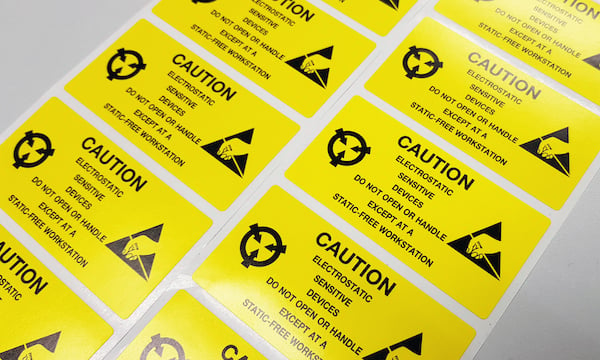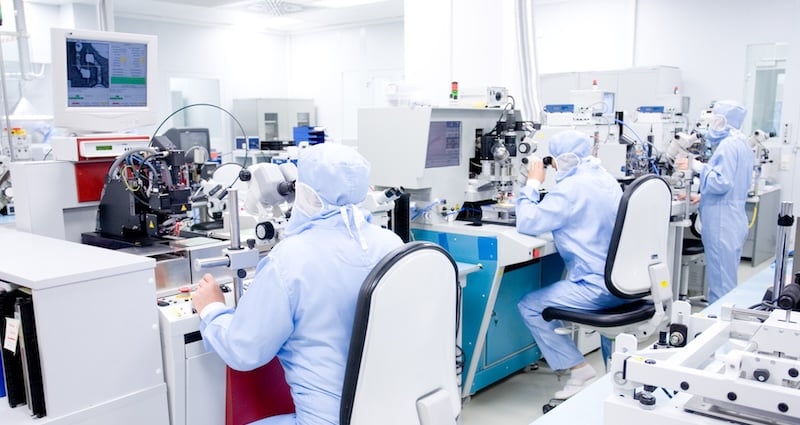
Electrostatic discharge (ESD) is a major concern in many manufacturing and industrial applications. Static can easily damage delicate electronics or medical device components – in some cases without warning or sign until after manufacturing is nearly completed.
In this blog, we’re sharing practical tips to implement that will help protect your workspace against ESD. Let’s dive in.
What is ESD?
ESD is the rapid emission of static electricity that occurs when a positively charged object touches a material with a negative charge. In layman’s terms, this buildup occurs when materials with differing charges slide or rub against one another. We feel ESD in many common occurrences, such as pulling static-filled laundry out of the drier or the slight shock of walking across a carpet and then touching a metal doorknob.
ESD can create a mild, if unpleasant, shock. However, in delicate manufacturing and other industrial processes, the heat generated by this shock can be incredibly destructive. In fact, it can vaporize minute electronic components. Static buildup can also attract contaminants to sensitive surfaces and cause delicate materials to adhere to one another.
The potential results? Catastrophic failure or a latent defect.
What causes ESD in controlled environments?
ESD can be particularly problematic in critical environments like cleanrooms and semiconductor manufacturing facilities, where even small discharges can damage sensitive electronic components or disrupt delicate processes. To prevent ESD in these controlled environments, proper ESD mitigation measures must be implemented, including the use of conductive or dissipative materials, grounded workstations, and proper training for personnel handling sensitive equipment.
In controlled environments, ESD can occur due to a few factors, including:
- Air dryness: Low humidity levels in controlled environments can increase the likelihood of ESD. Dry air reduces the conductivity of the air, making it easier for static charges to build up on surfaces and objects.
- Insulated materials: When you’re wrapping insulated materials (e.g., plastics or certain types of flooring) you can create static charges. When these materials come into contact with other objects, they can transfer the accumulated charge and cause ESD output.
- People and equipment: People and equipment movement can generate static charges through the friction between shoes or wheels on the floor.
- Equipment use or storage: In environments where electronic equipment is present, improper handling or poor usage can lead to ESD that can damage sensitive electronic devices.
The impact of ESD on your electronics
When looking at the effects of ESD on your electronics, know that if a component fails catastrophically, the device will fail quality and assurance testing. In this case, the faulty component would be identified early and replaced before the device is put in service, avoiding major diagnostic and repair costs.
However, latent defects are trickier – and are often far more costly to deal with – because the damage isn't immediately apparent. Let's say your instrument gets zapped (ESD) that didn't cause catastrophic damage at the time. The instrument burns in and passes testing. The true danger comes when it fails during operation. If a blender fails, dinner might be ruined. But if a navigational instrument on an airplane fails, you could end up in a life or death situation.
Since all materials are sources of ESD it's unlikely you could ever completely eliminate it from a job site. Instead, you have to try and protect against it. Let’s discuss how to make your environment “ESD safe”.
What does it mean to be “ESD safe”?
In a controlled environment, being ESD safe means you adopt vital safety measures and use products that effectively mitigate your overall risk. This includes ensuring that all equipment, tools, and materials being used have been designed and manufactured to minimize ESD generation and output.
As a result, one of the most critical components for controlled environment manufacturing is a swab that is specially constructed to clean small surfaces, and consistently apply precise amounts of solvents, all without the risk of transmitting damaging static shocks.
3 practical tips to protect against ESD
Now that we have a better understanding of what ESD is, let’s discuss some practical tips that will make your environment more ESD safe. It's crucial to guard critical instruments against ESD as much as possible. Protect your process and product through training, conscientious ESD-safe planning, and the right selection of tools for the job. A few easy-to-implement tips include:
- Grounding your work station: In the controlled environment of electronic assembly, an ESD-safe workstation is grounded to steer the current away from sensitive components. The bench is grounded, the technician wears a grounding strap, and the printed circuit board is designed with a ground plane, which serves as a return path for current from the components on the board, as a feature of the circuitry.
- Using electrostatic dissipative or anti-static tools and supplies: This will further protect electronic components during production or repair. These tools include ESD applicators. Puritan's line of applicators features seven different styles with ESD-safe plastic shafts. The polymer of these shafts is formulated with a thermoplastic compound of polypropylene blended with chemically coupled glass fibers to reduce static.
- Utilizing anti-static swabs: Anti-static swabs also help reduce risk. Some Puritan products have shafts that incorporate carbon, making four styles that are inherently “static-free.” In these, carbon reduces or eliminates buildup of static electricity.
To select the most appropriate ESD safe swab for these delicate jobs, it’s important to know your risks and understand what materials provide the best properties for ESD safe swabs. Which leads us to…
What swab materials are ESD safe?
An ESD safe swab is manufactured specifically to prevent this static buildup. These applicators are made with static dissipative handles and unique tips to prevent the electron transfer that can damage static-sensitive materials.
ESD materials come in several categories, including:
- Anti-static materials: Prevent the build-up of static electricity due to their high surface resistivity. While standard foam might normally allow static to build-up, ESD foams are chemically treated with agents that prevent their ability to generate a static charge.
- Conductive materials: Allows the easy flow of electrons, meaning that any potential electric charge is quickly dispersed. Many natural materials, including cotton and wood, are conductive.
- Static-dissipative materials: Allows the electric charge to flow in a slow, controlled manner to reduce the risk of ESD. Foam, often impregnated with carbon, features either very low or no initial charge and slows the transfer of an electric charge that may be generated by human contact. A polypropylene handle is another critical component of a static-dissipative swab.
It is important to remember in selecting a swab that you purchase materials that specifically state they feature ESD or anti-static features.
Materials to avoid in an ESD safe swab
The best material to use for an ESD safe swab will depend largely upon the specific task at hand. However, in general, it is best to avoid insulative materials. In general, this includes plastic and other synthetic materials, such as the polypropylene or nylon found in many swab handles and tips, respectively. The exception here is if the material features an additive that imbues it with static dissipative features. In fact, many ESD safe swabs feature polypropylene handles that are carefully designed to ensure any potential electric charge flows harmlessly away.
Why is it important to use an ESD safe swab vs a traditional one?
The small size of swabs makes them useful tools for cleaning and assembly of small devices, from electronic circuit boards to delicate medical devices. However, using the wrong swab can create a dangerous buildup of static electricity as your hands move against the swab handle. ESD safe swabs feature tips and handles that work together to prevent a buildup of electricity that can be released all at once.
While many natural materials offer conductive properties that can be useful for ESD applications, they can create other problems in cleanroom or controlled manufacturing environments. For example, cotton’s loose structure is prone to leaving lint that can be damaging in the production or cleaning of small electronics.
Choosing ESD swabs for your unique needs
Because ESD safe swabs are typically used in specialty applications, the static-related properties are likely only one of many features required by your swab. Many applications demand the use of a swab with a specific size or shape to their tip. Specialty options include:
- ESD small pointed swab: The tiny pointed tip on this swab is particularly useful for precision cleaning or applying precise amounts of adhesives, solvents or other fluxes to minute parts. Its static dissipative polypropylene handle protects electronic or medical device components from damage due to static charge while the foam tip prevents accumulation of any lint or residue.
- ESD mini tip foam swab: A smaller foam tip on this applicator helps remove particulates and apply precise amounts of solution to even the hardest-to-reach areas.
- ESD corkscrew tip swab: These foam swabs feature precision pointed tips that are useful for applying adhesives, solvents, solutions and other fluxes in manufacturing small electronic components or medical devices. The corkscrew design of the tip collects extraneous material, removing it from the surface being cleaned.
- ESD microfiber round swab: The use of soft microfiber makes this swab particularly suitable for use on optics and lenses. Its absorbent microfiber head has excellent wipe dry characteristics while remaining lint-free. It is also highly chemical resistant.
For any swab you choose, ensure it’s through a trusted partner that will help you understand the unique applications and characteristics for each.
When purchasing ESD swabs from a trusted partner, why choose Puritan?
Here at Puritan Medical Products, we understand that novel manufacturing processes demand new products. That’s why we work with customers to provide the right swab for every job. With over 100 years of experience serving customers with USA-made products, we’re committed to being the swab experts and helping you find exactly what you need.
Want to learn more about the swabs used in controlled environments? Download our free guide.
Ready to purchase swabs today? Our sales representatives are happy to help you determine which swab shaft and tip combinations are best for your specific manufacturing and industrial needs. Don’t hesitate to reach out with questions or for help on ordering the right products for your needs. Contact us today.




